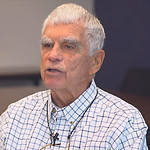About



From Thomas T. Weis
In 1964, Louis Lasagna, M.D. wrote an updated Hippocratic Oath. The oath included ten intentions. The third one caught my eye:
“I will remember that there is art to medicine as well as science, and that warmth, sympathy, and understanding may outweigh the surgeon’s knife or the chemist’s drug.”
I read his words for the first time in March 2025. I could relate. I wonder, “Is this the soul of medicine?” What do you think?

Tom Weis and Mike Hattwick met for the first time at St. Rita’s Hospital in Lima, Ohio, with unwavering determination, a bit of fear, and an abundance of compassion on Saturday evening, November 14, 1970. They gathered with the pediatric nurses and aides to face the impossible: care for an unconscious six-year-old boy with rabies. No human had survived rabies.
Well… not until the dawn of November 24, 1970, a nurse declared to Tom, the lead pediatrician, and Mike, the internist from the Center for Disease Control, “He’s better.”
The author details the treatment plan that focused on the pathophysiology of the brain, lungs, and heart and their interventions: a nurse continuously at his bedside, a hand-written pathophysiology flow chart on the wall, all medications at the nursing station, a Rickham reservoir, a tracheotomy, airway suction, a room next door for the family, and all the rest.
Also, she discovered that the memories revealed a whole other realm of care that is almost more noteworthy and carries a deeper legacy and lesson of historical record—the art of medicine. Skills like humility, mutual learning, agility, self-reflection, empathy, and ease of the unknown prevailed in caregivers’ descriptions of themselves, in how they communicated within the pediatric team, and within the hospital administration. These clinicians who worked for many decades after 1970 felt that these skills are timeless but also important for the next generation.
The book concludes by exploring the art of medicine. The author shares evidence-based research and contemporary training directed by three national physicians, Rachel Remen, Helen Riess, and Wayne Jonas, along with reflections from Lima clinicians, small culturally-based research studies by Hanna Ihlebaek, M.D., and Jonathan S. Ilgen M.D, a sampler of first person essays by Jennifer Bradley, N.P., Jean Paul Brutus, M.D., Gina Siddiqui, M.D., and books by Arthur Kleinman, M.D., Ph.D. and Dean-David Schillinger M.D.
Grab a colleague, a mentor, a classmate, a family member, or friend and share how these stories inform your professional or personal life.
Audience
The book is written for two major audiences. The general reader who may be interested in local or medical history. Rest assured no medical knowledge is required. The other audience includes readers working in healthcare. For this audience, clinical notes with medical terms are provide in sidebars. Also, see the appendix for the weblink to the “Recovery from Rabies Case Report” by Michael A. Hattwick M.D., Thomas T. Weis, M.D., C. John Stechschulte, M.D., George Baer, D.V.M., and Michael B. Gregg M.D. published in the Annals of Internal Medicine, 76, no.6 (June 1972): 931-942.
About the Author
(Molly) Mary F. Weis
Molly’s community work has been a mixture of program development and community arts administration in Lima, Ohio (including six years at American House) and the Jamaica Plain neighborhood of Boston, Massachusetts. She’s held a variety of roles with local chapters in Lima and Boston with the National Alliance on Mental Illness.
On the editorial side, she helped start up the Nonprofit Quarterly. She co-authored with Judith E. Gilbert and Martha S. MacDonell, A Moment for the Art: Sojourn Theatre and Lima Senior High Dialogue Project the Animating Democracy published by Americans for the Arts, Animating Democracy Project (2009). With Martha S. MacDonell, she wrote Beyond Our Imagination: Visionary Community Arts Projects in Lima, Ohio 1975-2003, (2019). Beyond Our Imagination is available in print or electronically through ArtSpace/Lima.
Molly has a bachelor’s degree with honors from Denison University’s sociology and anthropology department and a master’s degree in public policy from Tufts University’s department of urban and environmental policy studies.